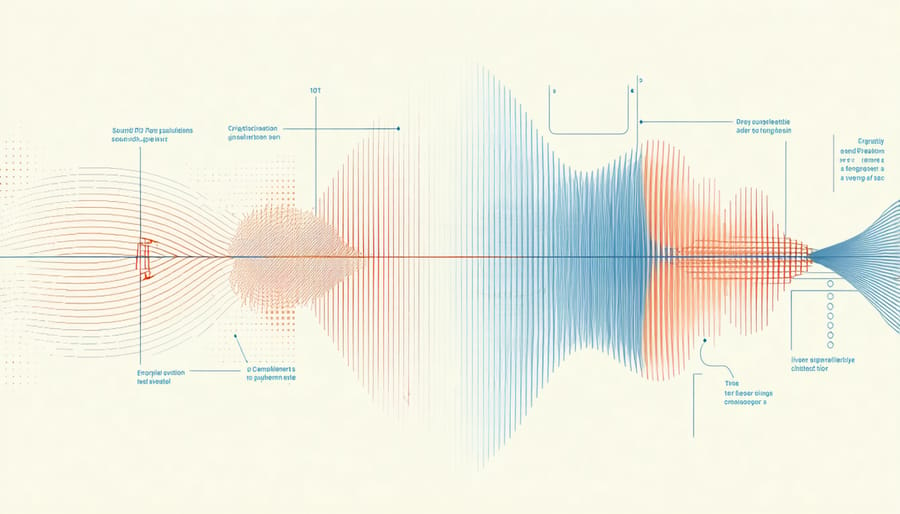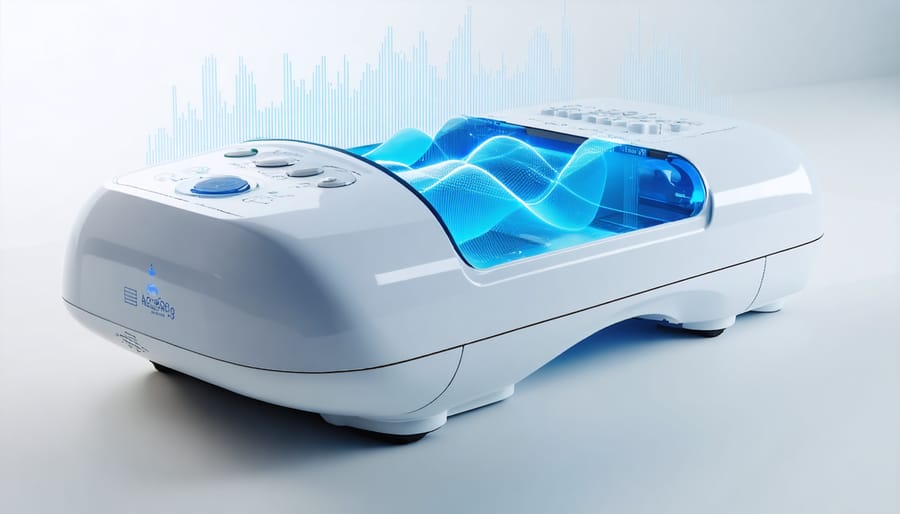Acoustic wave therapy has emerged as a promising non-invasive treatment option, backed by growing scientific evidence for its effectiveness in addressing various musculoskeletal conditions and chronic pain. This gentle yet powerful therapy uses precisely targeted sound waves to stimulate natural healing processes, improve blood circulation, and reduce inflammation in affected tissues. Clinical studies have shown particularly encouraging results for conditions like plantar fasciitis, tennis elbow, and chronic muscle pain, with success rates ranging from 65% to 85% in properly selected patients.
While traditionally available only in medical settings, recent technological advances have made acoustic wave therapy increasingly accessible for home use. The treatment’s appeal lies in its drug-free approach, minimal side effects, and ability to provide both immediate pain relief and long-term healing benefits. Understanding how acoustic wave therapy works and its proper application is crucial for achieving optimal results, whether you’re considering professional treatment or exploring FDA-approved home devices.
In this comprehensive guide, we’ll examine the scientific evidence behind acoustic wave therapy’s effectiveness, explore its various applications, and provide practical insights for those considering this innovative treatment option. We’ll focus on real-world results while helping you make an informed decision about whether acoustic wave therapy might be right for your specific needs.
What Actually Is Acoustic Wave Therapy?
The Science Behind Sound Waves
Sound waves are fascinating vibrations that travel through air, water, and even solid materials. When it comes to acoustic wave therapy, these waves work like tiny messengers, carrying energy through your body’s tissues. Think of them as gentle ripples in a pond, but with a specific purpose and direction.
These waves operate at different frequencies and intensities, which determines how deeply they can penetrate your body’s tissues. Low-frequency waves can reach deeper tissues, while higher frequencies work more on surface-level areas. When these waves encounter your body’s tissues, they create a series of compression and relaxation effects.
The interaction between sound waves and your body’s tissues triggers several responses. First, they can increase blood flow to the treated area, similar to a gentle massage. They also create tiny bubbles in the fluid between cells – a process called cavitation – which helps break down unwanted tissue buildup and stimulate healing responses.
Your body responds to these waves by activating its natural repair mechanisms, promoting tissue regeneration, and reducing inflammation. This scientific principle explains why acoustic wave therapy can be effective for various conditions, from muscle pain to circulation issues.

Different Types of Acoustic Therapy
Acoustic therapy comes in several forms, each offering unique benefits for home wellness. One popular method is vibroacoustic therapy, which combines sound waves with physical vibrations through specially designed furniture or mats. This creates a deeply immersive experience that many find helpful for relaxation and stress relief.
Sound bath therapy uses singing bowls, gongs, and chimes to create harmonious frequencies that wash over you. This gentle approach is perfect for meditation spaces and can be easily incorporated into any room with minimal equipment.
Binaural beats therapy delivers slightly different frequencies to each ear through headphones, helping to promote specific brainwave states. This method is particularly popular for home offices and bedrooms where focus or sleep is the goal.
White noise therapy, perhaps the most accessible option, uses consistent background sounds to mask disruptive noises and create a calm environment. You can start with a simple white noise machine or smartphone app to experience its benefits.
Each of these methods can be adapted to suit your space and wellness needs, making acoustic therapy a versatile addition to your home healing routine.
Evidence-Based Benefits and Limitations
Proven Benefits
Research has shown several compelling benefits of acoustic wave therapy, particularly when used consistently as part of a treatment plan. Clinical studies have demonstrated significant improvements in blood circulation and tissue healing, with many patients reporting reduced pain and increased mobility after regular sessions.
One of the most well-documented benefits is its effectiveness in treating musculoskeletal conditions. Studies show that 65-85% of patients experience notable pain reduction within 12 weeks of starting treatment. The therapy works by stimulating the body’s natural healing processes, encouraging the formation of new blood vessels and promoting tissue regeneration.
Another proven advantage is its non-invasive nature. Unlike surgical interventions, acoustic wave therapy doesn’t require downtime, and patients can typically return to their daily activities immediately after treatment. This makes it an attractive option for those seeking pain relief without the risks associated with surgery.
The therapy has also shown promising results in improving joint flexibility and reducing inflammation. Research indicates that regular sessions can lead to:
– Increased range of motion in treated areas
– Enhanced collagen production
– Better muscle recovery after exercise
– Reduced chronic inflammation
– Improved circulation in treated regions
These benefits are particularly notable because they often last longer than traditional pain management approaches, with some patients reporting continued improvement for months after completing their treatment course.
Known Limitations
While acoustic wave therapy shows promise in various applications, it’s important to understand its limitations. This treatment isn’t a miracle solution, and results can vary significantly from person to person. The therapy typically requires multiple sessions over several weeks or months to show noticeable improvements, and some individuals might not experience any benefits at all.
It’s crucial to note that acoustic wave therapy isn’t effective for all types of conditions. For instance, it may not help with severe structural issues or advanced tissue damage. The treatment also isn’t a substitute for necessary medical procedures or lifestyle changes that might be required to address underlying health concerns.
Cost can be a significant limitation, as many insurance providers don’t cover acoustic wave therapy treatments. Additionally, the effectiveness of at-home devices may not match the results achieved in professional settings, primarily due to differences in equipment quality and expertise in application.
Some users might experience temporary discomfort or minor side effects during or after treatment. While these effects usually subside quickly, they can impact the treatment schedule and overall experience. It’s also worth mentioning that the long-term effects of acoustic wave therapy are still being studied, and more research is needed to fully understand its limitations and potential risks.
Remember to consult with healthcare professionals before starting any new treatment regimen, as they can best determine if acoustic wave therapy is suitable for your specific situation.
Setting Up Acoustic Treatment at Home
Essential Equipment
For effective at-home acoustic wave therapy, you’ll need several key pieces of equipment to create an optimal treatment environment. The cornerstone of your setup is a quality acoustic wave therapy device, which typically includes a handheld applicator and a control unit. These devices come in various models, ranging from basic units for general wellness to more advanced systems with multiple intensity settings.
Essential accessories include conductive gel to ensure proper contact between the device and treatment area, comfortable padding or cushioning for support during sessions, and sanitizing wipes to maintain hygiene. If you’re planning to incorporate this therapy into your wellness sanctuary setup, consider adding a dedicated treatment table or reclining chair for comfort during longer sessions.
A timer is crucial for tracking treatment duration, and many users find it helpful to have a storage case or designated area to keep all equipment organized and protected. For those interested in monitoring progress, a journal or tracking app can be valuable additions to your equipment arsenal.
Remember to choose FDA-cleared devices when possible, and always ensure your equipment includes proper safety features like automatic shut-off and temperature control. While professional-grade equipment might be tempting, home-use devices are specifically designed with safety and ease of use in mind.

Room Setup Guidelines
Creating the ideal environment for acoustic wave therapy starts with proper room preparation. Choose a quiet space away from external noise sources, ideally with minimal echo. The room should be at a comfortable temperature, typically between 68-72°F (20-22°C), as extreme temperatures can affect the therapy’s effectiveness.
Consider implementing acoustic treatment solutions such as sound-absorbing panels or curtains to minimize sound reflection. Position your therapy equipment away from walls, preferably in the center of the room, to allow sound waves to disperse properly.
Ensure adequate ventilation while maintaining a draft-free environment. The room should be well-lit but not harsh – soft, ambient lighting works best. Remove any unnecessary furniture or objects that could interfere with the sound waves’ path or create unwanted reflections.
Keep the space clean and organized, with easy access to all necessary equipment. A dedicated therapy area helps maintain consistency in treatment and creates a more professional, focused environment for your sessions.
Safety Considerations
While acoustic wave therapy is generally considered safe when performed by qualified professionals, there are important safety considerations to keep in mind. Avoid this treatment if you have blood clotting disorders, are taking blood-thinning medications, or have active infections in the treatment area. Pregnant women and individuals with certain medical conditions, such as cancer or acute inflammation, should also steer clear of this therapy.
During treatment, you might experience mild discomfort or temporary redness in the treated area – this is normal. However, if you feel severe pain or unusual symptoms, alert your practitioner immediately. It’s crucial to choose a certified provider who uses FDA-approved devices and follows proper sanitization protocols.
Always have a thorough consultation before starting treatment, discussing your medical history and current medications. While at-home acoustic wave therapy devices are available, they should be used with caution and according to manufacturer instructions. For best results and safety, consider having your first few sessions with a professional who can demonstrate proper technique and monitor your response to the treatment.
Remember to maintain realistic expectations and follow post-treatment care instructions carefully to minimize any potential side effects.
Getting the Most from Your Treatment

Treatment Schedule
A typical acoustic wave therapy schedule involves multiple sessions spread over several weeks for optimal results. Most practitioners recommend starting with 6-12 sessions, usually scheduled twice per week. Each session typically lasts between 15-30 minutes, making it convenient to fit into your daily routine.
For those new to the treatment, your provider might suggest starting with two sessions per week for the first three weeks. This initial phase helps establish a foundation for healing and allows your body to respond to the therapy. After this period, sessions may be reduced to once per week for maintenance.
The exact duration and frequency of your treatment schedule will depend on several factors, including your specific condition, its severity, and how your body responds to the therapy. Some people notice improvements after just a few sessions, while others might need the full course of treatment to see significant results.
It’s worth noting that your provider might recommend a follow-up schedule after completing the initial treatment course. This typically involves monthly maintenance sessions to help sustain the benefits. Remember to discuss your personal treatment goals with your healthcare provider, as they can create a customized schedule that works best for your situation and lifestyle.
Complementary Practices
To maximize the benefits of acoustic wave therapy, consider incorporating complementary wellness practices into your routine. Regular exercise, particularly stretching and gentle movement activities like yoga or tai chi, can help improve circulation and enhance the therapy’s effectiveness. These practices also promote relaxation and stress reduction, which are essential components of any healing process.
Proper hydration and a balanced diet rich in anti-inflammatory foods can support your body’s natural healing mechanisms. Consider adding aromatherapy wellness practices to your treatment routine, as certain essential oils can help reduce stress and promote relaxation during therapy sessions.
Mindfulness meditation and deep breathing exercises before and after treatment can help you maintain a calm state, potentially enhancing the therapy’s effectiveness. Getting adequate sleep is also crucial, as it allows your body to repair and regenerate tissues more effectively.
Regular massage and gentle stretching can help maintain tissue flexibility and improve blood flow to treated areas. Consider keeping a wellness journal to track your progress and identify which complementary practices work best for you. Remember to consult with your healthcare provider before adding any new wellness activities to your routine, especially if you have underlying health conditions.
Acoustic wave therapy shows promising results for various conditions, particularly in treating musculoskeletal issues and improving circulation. While research continues to emerge, current evidence suggests it can be an effective treatment option when used appropriately and under professional guidance. The non-invasive nature and relatively low risk of side effects make it an attractive alternative to more aggressive treatments.
However, success largely depends on several key factors: working with qualified practitioners, following recommended treatment protocols, and maintaining realistic expectations about outcomes. It’s important to remember that results can vary significantly between individuals, and multiple sessions are typically required to achieve optimal benefits.
If you’re considering acoustic wave therapy, start by consulting with a healthcare provider to determine if it’s suitable for your specific condition. They can help develop a customized treatment plan and recommend reputable practitioners in your area. Keep in mind that while some at-home devices are available, professional treatment generally offers more consistent and reliable results.
For the best outcome, combine acoustic wave therapy with other recommended treatments and lifestyle modifications. Track your progress throughout the treatment period, and maintain open communication with your healthcare provider about any concerns or changes in symptoms. This comprehensive approach will help you maximize the benefits of acoustic wave therapy while ensuring safe and effective treatment.
